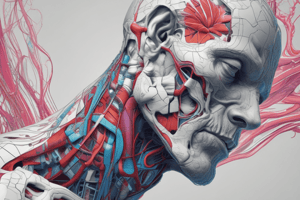Podcast
Questions and Answers
What is the largest level of organization in the human body?
What is the largest level of organization in the human body?
- Organ system
- Organism (correct)
- Organ
- Tissue
What is the name of the cavity that contains the heart, lungs, and major blood vessels?
What is the name of the cavity that contains the heart, lungs, and major blood vessels?
- Thoracic cavity (correct)
- Dorsal cavity
- Ventral cavity
- Abdominopelvic cavity
What is the term for 'toward the midline'?
What is the term for 'toward the midline'?
- Distal
- Lateral
- Medial (correct)
- Proximal
What is the term for the division of the body into anterior and posterior halves?
What is the term for the division of the body into anterior and posterior halves?
What is the term for the division of the body into left and right halves?
What is the term for the division of the body into left and right halves?
What region of the body includes the chest?
What region of the body includes the chest?
Flashcards are hidden until you start studying
Study Notes
Organization of the Body
- The human body is organized into several levels, from smallest to largest:
- Chemical (atoms and molecules)
- Cellular (cells)
- Tissue (groups of similar cells)
- Organ (structure composed of two or more types of tissue)
- Organ system (group of organs working together)
- Organism (the entire body)
Body Cavities
- The body has two main cavities:
- Dorsal cavity: contains the brain and spinal cord
- Ventral cavity: contains the thoracic and abdominopelvic cavities
- The ventral cavity is further divided into:
- Thoracic cavity: contains the heart, lungs, and major blood vessels
- Abdominopelvic cavity: contains the abdominal and pelvic organs
Directional Terms
- Used to describe the location of body parts:
- Anterior (front)
- Posterior (back)
- Superior (above)
- Inferior (below)
- Medial (toward the midline)
- Lateral (away from the midline)
- Proximal (near the trunk)
- Distal (away from the trunk)
Body Regions
- The body can be divided into several regions:
- Head and neck
- Thorax (chest)
- Abdomen
- Pelvis
- Upper limb (arm)
- Lower limb (leg)
- Back
Planes of the Body
- The body can be divided into three planes:
- Sagittal plane: divides the body into left and right halves
- Frontal plane: divides the body into anterior and posterior halves
- Transverse plane: divides the body into superior and inferior halves
Organization of the Body
- The human body is organized into six levels: chemical, cellular, tissue, organ, organ system, and organism
- Each level builds upon the previous one, with atoms and molecules forming cells, cells forming tissues, and so on
Body Cavities
- The body has two main cavities: dorsal and ventral
- The dorsal cavity contains the brain and spinal cord
- The ventral cavity contains the thoracic and abdominopelvic cavities
- The thoracic cavity contains the heart, lungs, and major blood vessels
- The abdominopelvic cavity contains the abdominal and pelvic organs
Directional Terms
- Used to describe the location of body parts
- Anterior refers to the front of the body
- Posterior refers to the back of the body
- Superior refers to a location above another point
- Inferior refers to a location below another point
- Medial refers to a location near the midline of the body
- Lateral refers to a location away from the midline of the body
- Proximal refers to a location near the trunk of the body
- Distal refers to a location away from the trunk of the body
Body Regions
- The body can be divided into several regions, including:
- Head and neck
- Thorax (chest)
- Abdomen
- Pelvis
- Upper limb (arm)
- Lower limb (leg)
- Back
Planes of the Body
- The body can be divided into three planes:
- Sagittal plane: divides the body into left and right halves
- Frontal plane: divides the body into anterior and posterior halves
- Transverse plane: divides the body into superior and inferior halves
Studying That Suits You
Use AI to generate personalized quizzes and flashcards to suit your learning preferences.




